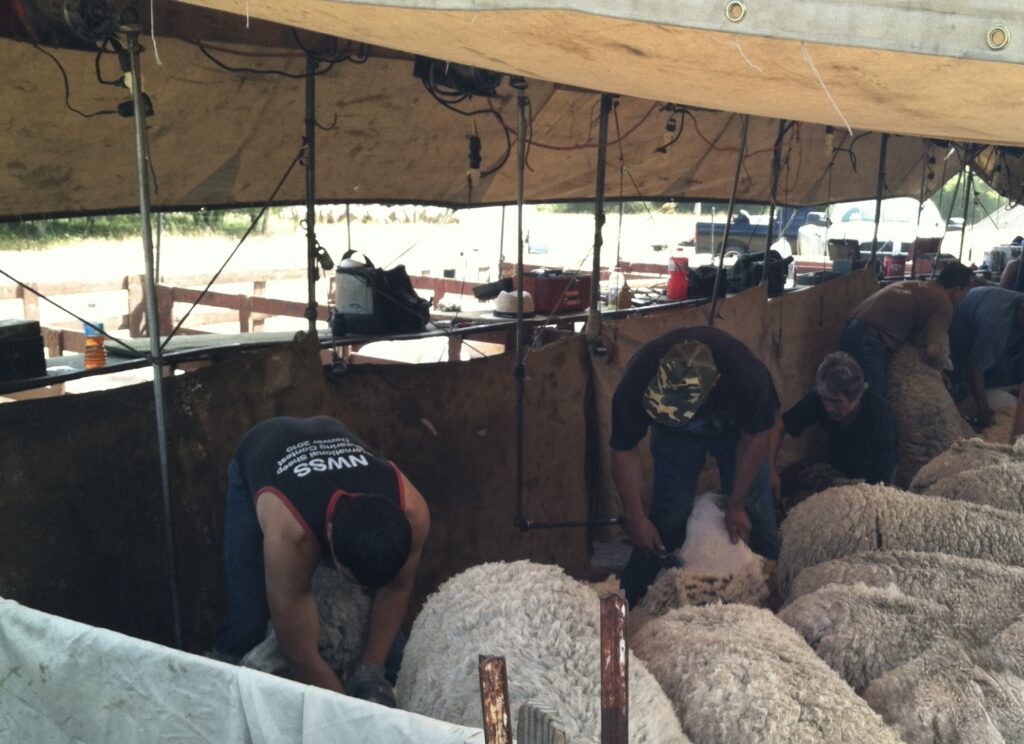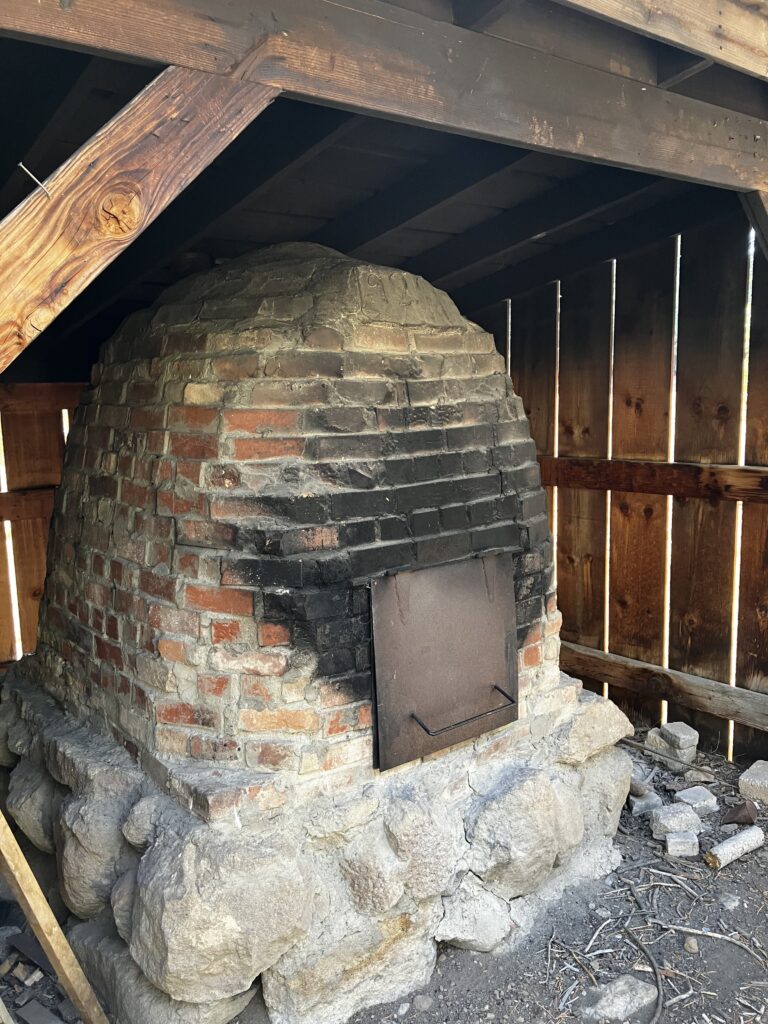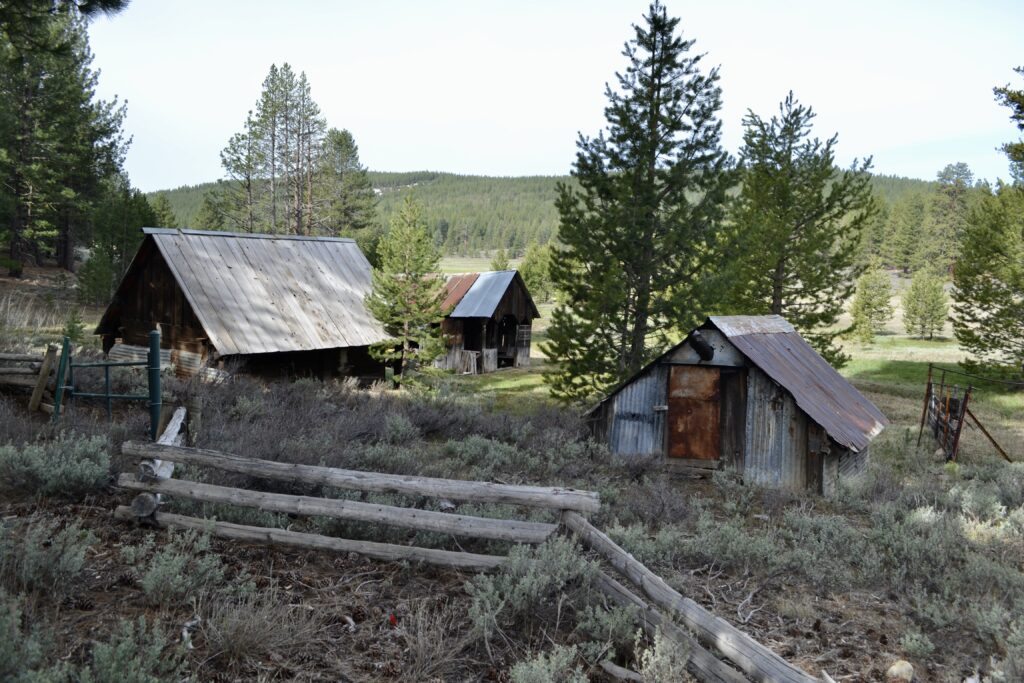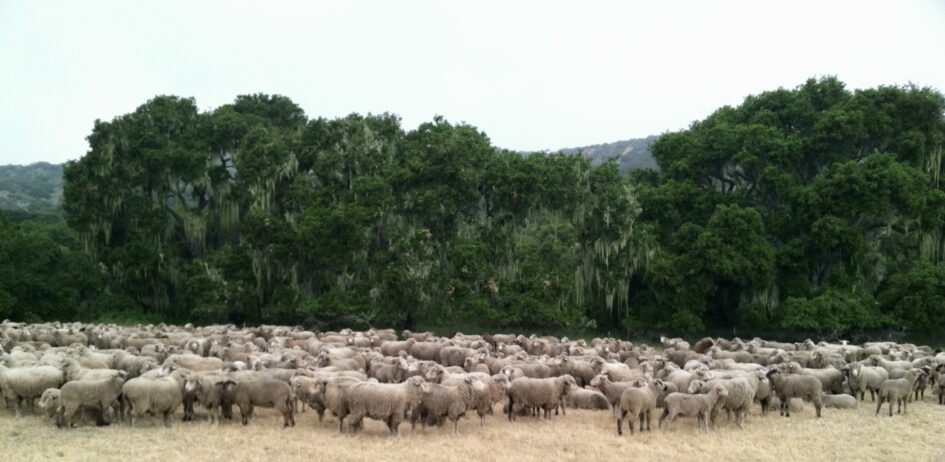We have a small cabin on our property that borders the Tahoe National Forest where sheep spend their summers grazing in a nearby meadow. One day last August, the flock—or the shepherd or the sheep dogs or some wayward wether—decided to cut across our lot on hunt, I guessed, to find fresh National Forest forage. It was something of a surprise, and it reminded me of the sheep we used to see grazing at the Fort Ord National Monument near Monterey.
A few years ago we stopped by there for “Sheep Appreciation Day.” In winter and early spring between 1998 and 2019, according to Christopher Hart, sheep grazed the coastal grasslands of the monument, part of an effort to control non-native vegetation and keep the fuel load low to prevent grass fires. Shepherds lived in trailers and moved the sheep across various areas of the monument with the help of trusty sheep dogs, all guarded by imposing Great Pyrenees, the white-furred massive dogs alert for coyotes and other predators. Local media often reported the arrivals and departures of the flocks, and lots of hikers and bikers had a great time watching the sheep graze their way across the landscape.

The main event of the celebration was a demonstration of sheep shearing, which took place in temporary corrals shaded by canvas. The soundscape was a blend of the hum of electric clippers and the bleating of the sheep and the occasional complaints by a small cadre of onlookers, offended at what they interpreted as a needlessly cruel practice. But the sheep seemed mostly docile enough, just like sheep are supposed to be. Of course the modern electric shearer is a vast improvement over the hand shears, as once described in Helen Hunt Jackson’s novel Ramona, which, as it happens, begins, “It was sheep shearing time in southern California. . .” (1). In the Golden State, sheep seem to inhabit their own space in California literature and history.
Shepherd’s Time Capsule
Some time ago, the story goes, a hiker and his canine companion ascended to the top of Mount Givens, which rises better than ten thousand feet in the southern Sierra northeast of Huntington Lake. On the peak, the hiker found a rusting old tobacco tin. Inside, National Forest Service archeologist Steve Marsh tells us, were a “number of notes left by local sheepman Dunford Thornton and his herders between 1922 and 1938” (1). This “time-capsule of penciled notes” says Marsh in his essay, “can remind us of a time nearly three-quarters of a century ago when flocks of sheep and the men who herded them roamed what we now often think of as natural wilderness.”
Marsh briefly turns to John Muir’s famous description from his 1911 memoir My Boyhood in the Sierra. In 1869, Muir worked, on behalf of an absent owner, as a kind of supervisor over a shepherd and a flock of sheep. In his book, Muir famously calls sheep, “hoofed locusts,” a term that for over a century has contributed to bad attitudes about sheep grazing in California. But that’s obviously not the whole story, as Marsh helps us to appreciate, thanks to his recounting of the history of herding sheep in the Sierra by drawing on Dunford’s notes and a wealth of primary research.
“The earliest note was left in the can in 1922. It reads simply ‘Dunford Thornton and Charley Drummond here with sheep on Sept. 3, 1922,’” says Marsh (2). The note isn’t very discursive, but it’s wonderfully evocative, reminding me how deeply sheep and shepherding are embedded in California writing, with authors often using the supposed “hooved locusts” as vehicles for advancing California themes, especially through stories featuring competing, sometimes antagonistic, views on land use in California. Prominent among these works are four California mainstays, as already mentioned Jackson’s 1884 novel Ramona, but also in Frank Norris’ 1901 novel The Octopus, Mary Austin’s 1907 book of sketches The Flock, and, of course, Muir’s memoir. I’ll touch on each of these (I’ve written about Ramona and The Octopus in a previous post), but then I’ll focus on a lesser known work, Robert Laxalt’s Sweet Promised Land. First published in 1957, this beautiful memoir recounts the life of Laxalt’s sheepherder father, a Basque immigrant, and his late-life visit to his Pyrenes homeland.
Vanishing Pastoral
Before Muir published My Boyhood in the Sierra, but not before he became a hapless pseudo-shepherd in Yosemite Valley, Helen Hunt Jackson published her 1884 muckraking classic. Set just after the 1848 takeover of California by the United States, Jackson tells a melodramatic story of a doomed romance between the beautiful Ramona, a half-native young woman growing up in a prominent Californio household, and Allesandro, the handsome son of Temecula Indian Chief Pablo and a man skilled in the art of the shepherd. It seems, actually, that there’s pretty much nothing that Allesandro can’t do. He even sings. The novel’s romance was meant as a sweetener, a familiar fairy tale upon which to hang a story about the poor treatment Americans meted out to California Indians.
It was also a paean to a vanishing pastoral way of life, tidy and bucolic, certainly a seductive romanticized myth. Jackson portrays that myth partly by focusing on sheep. Here, she gives us the nineteenth century version of “Sheep Appreciation Day,” paying close attention to the sonic tapestry, which, sans the buzz of electric clippers and the complaints of squeamish onlookers, seems not that much different than what we heard at Fort Ord:
The thirty shearers, running into the nearest pen, dragged each of his sheep into the shed, in a twinkling of an eye had the creature between his knees, helpless, immovable, and the sharp sound of the shears set in. The sheep-shearing had begun. No rest now. Not a second’s silence from the bleating, baa-ing, opening and shutting, clicking, sharpening of shears, flying of fleeces through the air to the roof, pressing and stamping them down in the bales; not a second’s intermission, except the hour of rest at noon, from sunrise till sunset, till the whole eight thousand of the Senora Moreno’s sheep were shorn. It was a dramatic spectacle. (76)
In Ramona, pastoral values aren’t appreciated by mercantile and sometimes unscrupulous Americans, a point that a later novel, The Octopus, returns to. Once again, sheep get their closeup. And not in a good way.
In his 1901 novel, Norris scrutinizes the then rapid emergence of the power of the railroad trusts and their influence on commerce and development in the Golden State. Norris draws upon the 1880 Mussel Slough gunfight between members of a supposedly traditional agrarian community and agents of the faceless, amoral railroad trusts that they claimed exploited them. In order to emphasize the conflict, early in the novel Norris describes the “Octopus,” the destroying, tentacled railroad monster whose body is a train engine, which slaughters a flock of sheep tended by the mystic shepherd Vanamee:
In some way, the herd of sheep—Vanamee’s herd—had found a breach in the wire fence by the right of way and had wandered out upon the tracks. A band had been crossing just at the moment of the engine’s passage. The pathos of it was beyond expression. It was a slaughter, a massacre of innocents. The iron monster had charged full into the midst, merciless, inexorable. To the right and left, all the width of the right of way, the little bodies had been flung; backs were snapped against the fence posts; brains knocked out. Caught in the barbs of the wire, wedged in, the bodies hung suspended. Under foot it was terrible. The black blood, winking in the starlight, seeped down into the clinkers between the ties with a prolonged sucking murmur. (47)
Ramona and The Octopus both helped to establish sheep as a symbol in California’s literary imagination. The former portrayed them as part of a tranquil, vanishing pastoral landscape, threatened by the heedless development promised by Americans streaming into California; the latter showed that process when more fully manifested, the pastoral having given way to large scale development. Now sheep, avatars of innocence, are no longer only shorn, they’re gruesomely slaughtered, symbolic stand-ins for the working men and women unable to thrive under large scale capitalism.
So, Where Do I Graze My Flock?
When John Muir compared sheep to a plague of locusts in My Boyhood in the Sierra, we can now see that he was upending a long-standing literary convention wherein sheep were mild and innocent, harmless creatures and occasional victims. Still, it’s not like sheep didn’t have a bad reputation in the west, something that Muir well knew. His concern, the reason for his bad-baaing the beasts, was the nature of the stock business in California:
On through the forest ever higher we go, a cloud of dust dimming the way, thousands of feet, trampling leaves and flowers, but in this mighty wilderness they seem but a feeble band, and a thousand gardens will escape their blighting touch. They cannot hurt the trees, though some of the seedlings suffer, and should the woolly locusts be greatly multiplied, as on account of dollar value they are likely to be, then the forests, too, may in time be destroyed. Only the sky will then be safe, though hid from view by dust and smoke, incense of a bad sacrifice. (128)
Muir was drawing on his past experience to warn his contemporaries about overgrazing. The point, says scholar Barney Nelson, was similar to the one made earlier by Mary Austin in The Flock, but her perspective brought what to Muir might have been a threatening twist:
On both literal and symbolic levels, Muir and Austin wanted to protect natural resources from ravaging hordes, but their perceptions regarding the identity of those hordes differed considerably. Muir feared the common rural masses and their domestic animals; Austin feared the unquenchable urban thirst for water and recreation. Muir wanted to preserve beautiful places for escape and enjoyment; Austin wanted to preserve sustainable rural communities. (223)
In fact, says Nelson, Muir may have had Austin’s work in mind when he wrote his memoir, for her version of California sheep raising was far more sympathetic than his: “Realizing how powerfully Austin had structured her literary argument supporting working shepherds, Muir may have felt that both Yosemite National Park and tourism itself were threatened” (225).
The Flock is an unconventional book. Nelson calls it “a boundary-blurring collection of sketches about sheepherding in the Sierra, merging nonfiction and myth into a multivoiced, dialogic narrative” (223). One of its strengths is that much of it is based on Austin’s time spent in the company of shepherds, whom she portrays with great sympathy. The book shows an alternative way of life, maybe a radical one, that stands against the inherently unsustainable wave of development and tourism encroaching on grazing lands. On offer along the way is some astoundingly beautiful writing. From a chapter called “The Open Range”:
Let me tell you this,—every sort of life has its own zest for those who are bred to it. No more delighted sense of competency and power goes to the man who from his wire web controls the movement of money and wheat, than to the shepherd who by the passage of birds, by the stream tones, by the drift of pine pollen on the eddies of slack water, keeps tally of the pastures. Do you read the notes of mountain color as they draw into dusk? There is a color of blue, deeply pure as a trumpet tone low in the scale, that announces rain; there is a hot blue mist suffusing into gold as it climbs against the horizon, that promises wind. There is a sense that wakes in the night with a warning to keep the flock close, and another sense of the shortest direction. The smell of the sheep is to the herder as the smack and savor of any man’s work. Also it is possible to felicitate one’s self on rounding feeding flock and bringing it to a standstill within a flock-length. (92-93)
Later, Austin defends the grazing of sheep from the familiar complaints that sheep ruin the land they graze. Austin argues that the problem isn’t inherently due to the character of the sheep but to the character of sheep men who do not recognize that “there is always a point beyond which it is not well to push any native industry to the wall” (210). As for the sheep themselves, “They clean up the dry grass and litter by which the smouldering fire creeps from pine to pine; ranging moderately on the hillslopes they prune the chaparral which by smothering growth and natural decay covers great areas with heaps of rubbish through which the shrub stems barely lift their leaf crowns to the light and air” (210).
Austin had begun The Flock by recounting much of the history of raising sheep in California, stretching all the way from the Spanish missionaries to Austin’s own time. Steve Marsh’s exploration of Dunford Thornton’s life as a sheep man offers an updated variation of this narrative. The Gold Rush, he points out, created a burgeoning market for food and wool in the camps. After the Gold Rush, some sheepherders “drove their flocks into the Central Valley where they encountered strenuous resistance from the cattlemen until the drought of the mid-1860s served to undermine the cattle industry and show that sheep required less grazing land per head” (2-3). Eventually, the Forest Service began issuing grazing permits in the high country and enforcing their strictures. Some sheep men converted to cattle, but others did not, continuing the pattern of wintering in the Central Valley and driving the sheep into the mountains for summer.

This evolving system was much influenced by Basque immigrants. After moving to the high country in summer, Basque shepherds watched over the sheep, but were themselves supported by tenders who brought them supplies through the summer months. In the Sierra, sheep camps were established, where tenders could camp, bake bread for the shepherds, and, from that location, distribute the supplies. One of these camps was the Wheeler Sheep Camp, one of the main sheep camps of the Wheeler Sheep Company located in Reno. The Kyburz Flat site, a scant mile and half east of Highway 89 and the Little Truckee River, features a Tahoe National Forest exhibit that tells how the camp “was built and managed by John Martin Gallues, an immigrant from the Basque homeland in Spain. Martin and his brother Felix built several of the camp’s structures before 1921.”
Buildings from the camp are long gone. But you can still inspect a replica of the kind of Basque oven that tenders used for baking bread to feed the shepherds. I visited the site this spring and took in the view across meadow and marsh foliage. Most of Kyburz Flat is surrounded by pines, and it’s not hard to imagine the meadow being browsed by countless sheep and tended by a shepherd and a dog or three. That was the world Dominique Laxalt found when he arrived in the West.
His Home Was the Hills
In Sweet Promised Land, Robert Laxalt tells overlapping stories. One recounts his father’s experiences as a sheepherder; another laces in how his family adjusted to Dominique’s absences from the family home in Carson City; the last tells an archetypal immigrant story about his father’s late-life return to his birthplace to reconnect with a family he hadn’t seen for decades. The book begins this way:
My father was a sheepherder, and his home was the hills. So it began when he was a boy in the misted Pyrenees of France, and so it was to be for the most of his lifetime in the lonely Sierra of Nevada. And seeing him in a moment’s pause on some high ridge, with the wind tearing at his wild thickness of iron-gray hair and flattening his clothes to his lean frame, you could understand why this was what he was meant to be. (1)
It’s a striking opening, offering an image of a sheepherder at far remove from the description of an ignorant, uncouth caricature on offer from John Muir, who claimed that solitude led the shepherd to become “semi-insane or wholly so” (31). For Dominique, being a shepherd was a calling worthwhile.
His son Robert describes an unconventional home life. Dominique had met his future wife, “when he was rich in sheep. She was Basque too, although raised more gently than my father in the soft lowlands of the French Pyrenees” (9). Her family had run a small hotel and a travel agency in France. After she married Dominique, they bought a small hotel and moved to a house in Carson City. Years later, when he realized that none of his four boys were going to follow in his footsteps, he sold his sheep and signed on as a “herder for a big sheep outfit in the next valley. He had gone back to the mountains to stay” (15). Robert writes, “our family spent half its growing-up life looking for my father” (10).
One summer, after Robert married and had his own child, he went looking for Dominique, once again a “trying adventure” (16), but a typical one:
Faintly, borne up and muted with the whir of the wind through the pines, came the sound of bells and bleating. It was a sheep camp. I filled my lungs and yelled, and in a little while my father answered. It came cupping down through the canyons in a call as old as the first Basque mountain man. It was my father’s sheep camp. (17)
In town, “when the bands had been brought down from the high mountains to the valley ranch”:
It was a time of conversation and visiting. The soft flow of Basque filled the corrals until the long noonday rest. Although they rose at daylight and worked in the corrals until the long noonday rest, they paused often in the milling dust to lean against a fence and tip back their sweaty hats and visit. They spoke of how their bands had fared in the mountains and where the feed was good and of their dogs and the endless troubles with the burros. They spoke of the outfit and how they treated their men, and of the time the camptender who brought the supplies had committed the unpardonable sin of forgetting the wine. And how they were treated was important because they were Basques and their pride was their flaming shield, and they took insult from no man. (27-28)
Reading Robert’s memoir, what strikes me most is the fitness of Dominique for his life. As the book relates the story of Dominique’s return to his boyhood home, Tardets, France, he describes to his family his arrival in the west:
My father’s head was bent a little, and with one leathered hand he began rubbing a knot in the old wood of the table. “It happened when I was new in America and they sent me into the deserts to herd sheep. You would have to see that country to believe it, but it was so big that even from the top of the highest hill I couldn’t see a town or a house, except one little cabin and a corral that were hidden in this gully far below where I had the sheep.” (97-98)
When Dominique and Robert leave to come back home, Dominique, an immigrant to America captured by its bigness, its emptiness, tells his son he can’t come back to France for another visit: “It ain’t my country any more. I’ve lived too much in America to go back. . . . Don’t you know that?”
Robert gets it, and ends the book this way:
And suddenly before me, I saw the West rising up at dawn with an awesome vastness of deserts and mighty mountain ranges. I saw a band of sheep wending their way down a lonely mountain ravine of sagebrush and pine, and I smelled their dust and heard their muted bleating and the lovely tinkle of their bells. I saw a man in crude garb with a walking stick following after with his dog, and once he paused to mark the way of the land. Then I saw a cragged face that that land had filled with hope and torn with pain, had changed from young to old, and in the end had claimed. And then, I did know it. (158)
Russell Valley

There’s another Sierra sheep campsite not far from the one at Kyburz Flat. It’s no longer in use, its cabins and corrals now listing with neglect. But sheep still graze nearby in an adjacent Russell Valley meadow, the same sheep which trundled across our property last summer. After winter snows melt, the meadow is lush with foliage. Sheep shearing time in the rear view mirror, the flock generally arrives in late spring and stays into the summer for breeding and good grazing. Trucked in from the Central Valley, they’re tended by a shepherd who keeps camp in a small trailer parked, at least it was last summer, on the side of a dirt track that leads from Dog Valley Road over a gentle rise to the old camp.
These were the sheep that climbed the slope leading to our cabin last summer. If John Muir were a witness, he would probably have been appalled. But I bet Dominique Laxalt would have been thrilled. I know I was.
Sources
Austin, Mary. The Flock. Houghton Mifflin, 1906. Internet Archive. https://archive.org/details/flock00aust.
Flying Mule Sheep Company. “Sheep Camp Summer.” Foothill Agrarian: Thoughts about Sustainable Agriculture and Forestry from the Sierra Nevada Foothills. 27 July 2019. https://flyingmule.blogspot.com/2019/07/sheep-camp-summer.html. Accessed 24 April 2025.
Hart, Christopher. “Sheep and Goat Grazing on Fort Ord National Monument from 199802019: Implications for Restoration.” Masters of Natural Resources Graduate Project. Oregon State University, Spring 2020. https://ir.library.oregonstate.edu/concern/graduate_projects/3r075240t. Accessed 1 April 2025.
Jackson, Helen Hunt. Ramona. Roberts Brothers, 1884. Internet Archive. https://archive.org/details/ramonastoryrober00jackrich.
Laxalt, Robert. Sweet Promised Land. U of Nevada P, 1957.
Marsh, Steve. “Sheep Herding in the Sierra National Forest as Told from Notes in a Can Left by Dunford Thornton, Sheepman 1922-1938.” Forest Service, United States Department Agriculture. 2014. https://web.archive.org/web/20170212111703/https://www.fs.usda.gov/Internet/FSE_DOCUMENTS/fseprd499743.pdf. Accessed 1 September 2025.
Muir, John. My First Summer in the Sierra. Houghton Mifflin. 1911. Internet Archive. https://archive.org/details/myfirstsummerins00muir.
Nelson, Barney. “The Flock: An Ecocritical Look at Mary Austin’s Sheep and John Muir’s Hoofed Locusts.” Exploring Lost Borders: Critical Essays on Mary Austin. Ed. Melody Graulich and Elizabeth Klimasmith. U of Nevada P, 1999. pp. 221-42.
Norris, Frank. The Octopus. Doubleday, 1901. Internet Archive. https://archive.org/details/octopusstorytwo00norrrich/page/n3/mode/2up.
Tahoe National Forest. “Wheeler Sheep Camp.” Trailside Exhibit.
Want to be notified when new posts are added? Subscribe to our newsletter.

